|
|
|
Fiber Optic Multiplexors FMUX/S and FMUX/B
(4, 8 and 16 E1 ports; w/o Ring Support)
Discontinued, recommended replacement is: FMUX/M, FMUX/S
Specifications
Optical Transceiver Parameters
Documentation
|
Models Table | |||||||||||||||||||||||||||||||||||||||||||||||||||||||||||||||||||||||||||||||||
| |||||||||||||||||||||||||||||||||||||||||||||||||||||||||||||||||||||||||||||||||
Documentation
Features
|
Multiplexors FMUX-4E1, FMUX-8E1 and FMUX-16E1 transmit 4/8/16 E1 channels respectively over the fiber optic link. All channels have independent sync signals with their own frequencies.

There are 5-channel and 18-channel versions for transmission of four E1 channels and one/two digital port channel (Ethernet 10/100Base-T and/or V.35/RS-530/RS-232/X.21).
FMUX has LEDs for channels ready state, optic transceiver operability, loopbacks enable state and test mode indication. Internal loopbacks and integral BER tester operation are controllable by the console port located on front panel. BER tester meters bit error rate in optic link using permanent or pseudo random code in compliance with the ITU-T O.151 Recommendation (test sequence length equals to 223-1=8388607 bits).
Remote device management is available by remote login feature. Service data exchange is supported by additional service channel using same optic link.
Device state can be monitored by SNMP using dedicated Ethernet 10Base-T port ("-SNMP" option available for "/S" version must be ordered).
Alarm indication relay with "dry contacts" interface in compliance with the ITU-T G.742 Recommendation, paragraph 10, is supplied.
The firmware of the device can be updated by user.
| E1 Interface (2048 kbit/s) | |
|---|---|
| Connector Type | RJ-48 (female 8 pins) |
| Line Code | HDB3 |
| Framing | Transparent; both framed and unframed modes supported |
| Error Detection | Bipolar Violation |
| Line Impedance | 120 Ohm (Twisted Pair) |
| Receive Signal Attenuation Range | From 0 to -12 dB |
| Jitter Attenuator | In transmit path |
| Overvoltage Protection | TVS |
| Overcurrent Protection | Fuse |
| Alarm Interface | |
| Connector Type | desktop version: 6 pin Mini DIN 1U version: DB-9 (male) |
| Relay Contact Current | Up to 600 mA |
| Relay Contact Voltage | Up to 110 VDC; up to 125 VAC |
| Console interface | |
| Connector Type | RS-232 DCE, DB-9 (female) |
| Protocol | Asynchronous, 9600 bit/s, 8 bit/symbol, 1 stop bit, no parity |
| Modem Control Signals | DTR, DSR, CTS, RTS, CD |
| Diagnoctic modes | |
| Loopbacks | Local, Remote |
| BER Tester | Built-in |
| Control | Via console RS-232 port |
| Physical | |
| Box | Desktop or 1U rack mount for 19-inch cabinet |
| Dimensions | 200 mm x 260 mm x 65 mm (desktop version) 444 mm x 262 mm x 44 mm (1U version) |
| Weight | 1100 g (desktop version) 3400 g (rack-mount version) |
| Power source | |
| AC power source | 176-264 V, 50 Hz |
| DC power source | 36-72 V |
| Power consumption | 20 VA Max |
| Environment | |
| Temperature | 0° - 50°С |
| Humidity | 0 to 80 %, non-condensing |
Return to Fiber Optic Modems and Multiplexors or Digital Communication Equipment
Copyright © 1996-2026 Cronyx





